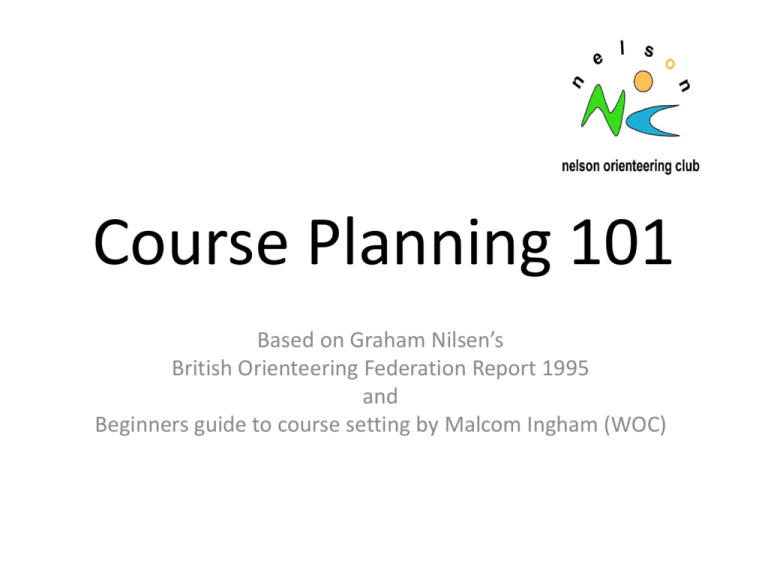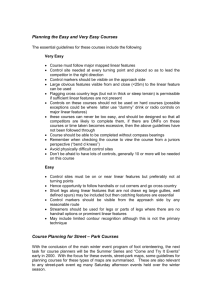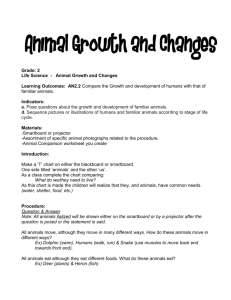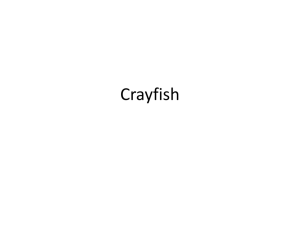Course planning 101 - Nelson Orienteering Club
advertisement

Course Planning 101 Based on Graham Nilsen’s British Orienteering Federation Report 1995 and Beginners guide to course setting by Malcom Ingham (WOC) The course planner should have two aims: • to leave the competitors feeling that they have enjoyed themselves, having been stimulated both mentally and physically • to plan fair courses which will result in the best orienteer winning. PHASE 1 Pre-Planning Checks • Determine Key Personnel – Controller – Event Organiser – Map Co-ordinator – Landowner Liaison Positions of start and finish • access to complex terrain for the harder courses without 'dead running' at the beginning and end of the course • access to simple terrain for the easiest courses - can beginners get from start to finish without leaving well-defined line features? • can the start be laid out in such a way that competitors starting are hidden from the view of those waiting at the pre-start? • competitors must arrive at the finish from a predictable direction: use a finish funnel, with the finish in an obvious place, or use tapes from a simple last control or use only those controls from which finishers will 2. better to use tapes to bring finishers in from naturally come from predictable directions predictable directions 1. chaos – finishers come from all directions 3. or use only those controls from which finishers will naturally come from predictable directions • all other things being equal, a particularly scenic finish location helps to create a good atmosphere • It may be that, once you start the planning, you find it difficult to plan certain courses. Don't be afraid to try moving the start (or, less easily, the finish) to another position. Initial reconnaissance • Have a look around as much of the area as possible before planning. • Try to identify the nicest parts of the area for running through, and the sections where it will be difficult to avoid competitors seeing controls from a long way off. • Are there any parts too rough and/or steep for the more senior competitors? • What are any roads in the area like for traffic, and for visibility at possible crossing points? • Are walls and fences, and any large streams, easily crossable (particularly for younger and older competitors) without risk of damage, or will crossing points be necessary? • It is worth at this stage checking likely start and finish sites for suitability. Choosing your course lengths • There is no guaranteed route to success, merely suggestions which seem to work reasonably well most of the time. • First, assemble your sources of information: * results of previous events on the same area * results of recent events on similar terrain • For these events, try to find out about any factors which might affect your event differently: * vegetation (forest growth/thinning/brashing; undergrowth) * adverse weather * % height climb * master maps/pre-marked maps used * quality of competitor * were the shorter courses predominantly in faster (or slower) parts of the area? and treat the results with caution accordingly. Restrictions on planning • Now is the time to find out about these. They may include: – conservation – forestry work : is any felling/thinning planned before the date of the event? This may need checking more than once over the months before the event. – crossing points * are there any walls/fences which, at the request of the landowner, are to be crossed only at special crossing points? * where can roads be crossed safely, and do they require specific crossing points? * other conditions of use - e.g. out of bounds areas around housing; fields – which will have livestock in them at the time of the event - many children are frightened of cattle, for instance – terrain: in particular, are there parts of the area unsuitable for older competitors because of steepness or roughness, or because the map is too difficult to read? – Remember also to check on access to the area for checking control sites etc. PHASE 2 Armchair planning Some Fundamentals • Vegetation Largely beyond the planner's control, but do make good use of the nicest bits you've got, • Variety of terrain used If you have a mixture of, say, open and wooded, try for repeated changes from one to the other rather than just starting in one and finishing in the other. More Fundamentals • Variety of legs Many legs of similar length and direction lead to boredom. More Fundamentals • Variety of legs This sort of course breaks up the competitor's rhythm far more successfully: Functions of controls • There are four: 1. (most importantly) to provide a good leg - one full of map-reading, route choice, etc, through good terrain 2. to move the competitor from the end of one leg to a better starting point for a good leg 3. avoiding dog legs 4. 'collecting' - guiding competitors around a sensitive area, or leading them into a compulsory crossing point. • It is the navigating between controls which is important, not the finding of the markers themselves. Having planned your course, consider each control carefully – what is its function? Will the course be just as good, or even better, if the control is left out? Long Legs • Long legs are best at testing route choice • What are the attributes of a good long leg? * several possible routes, with the quickest being navigationally the hardest * routes involve going cross-country over intricate terrain, or linking many different paths together - mental problems posed throughout the leg * fairness - it must be possible to decide between the available routes solely from the information on the map. What looks the quickest on the map must also be the quickest on the ground * several choices equivalent as far as possible, to split competitors up with e.g. fast runners following a longer route to use paths whilst a slower but stronger runner goes straight. Competitors with different strengths and weaknesses will consider different routes to be the quickest * no one leg should be more than 20% of the course length, lest the result of the race hinge on one decision. However, the two longest legs of the course together should be around 33% of the course length, in order that route choice be adequately tested Short Legs • Properly planned, short legs should always be good at testing fine map reading and (if the terrain allows) contour interpretation, as well as compass and pacing skills. • Short legs force competitors through the terrain. The best routes will generally be straight-line ones, the problems are in following those routes rather than in selecting them • No use of line features, throughout their length. Any 'catching features‘ should be behind, not in front of, the control. • Controls requiring compass and pacing need particular care due to inaccuracies and needs to be visible to a person missing it by a distance of around 10% of the distance from the attack point Pitfalls to avoid 1 • Dog legs: these fall into two categories: – optimum route out = reverse of the optimum route in. – abrupt changes in direction, such that a competitor missing the control to one side could be led in by another competitor leaving the control Pitfalls to avoid 2 • conflicting directions (eg. L18-19, R23-24); Pitfalls to avoid 3 • “bingo” and hidden controls; Pitfalls to avoid 4 • • • • • unnecessary/excessive climb; overuse of green/physical areas; crossing out of bounds areas/edge of the map; too many controls; too close controls. Putting ideas to paper • • • • a blank map and a pencil a piece of acetate film use string and map pins OCAD • Remember the hardest legs to plan are long legs. Before trying to plan any courses, spend some time planning long legs on the map: even if you subsequently don't use those legs, this will help 'get your eye in' and will alert you to the possibilities available. • For each course (except the beginners' courses), first plan the long legs, then build the rest of the course around them, making as much use as possible of the pleasant and technically difficult parts of the area, but trying not to overload any one section with competitors PHASE 3 Course difficulty Levels of technical difficulty Navigational difficulty comes in 4 levels: • hard (red); • medium (orange); • easy (yellow); • very easy (white). Red • Controls on point features; • no obvious attack points or catching features close to controls; • requires detailed map-reading, route choice, compass skills; • not easy to relocate. Who is it for? all grades from M/W-16A upwards. Orange • Controls on prominent point features, prominent contour features, line features; • obvious attack points and catching features within reasonable distance; • requires reasonable map-reading and route choice; • easy relocation. Who is it for? M/W-14A and all B grades. Yellow • Controls on or near (< 50 m) drawn linear man-made or water features; • controls preferably not at turning/decision points; • controls visible from the approach side by any reasonable route; • follows line features but allows limited route choice (“corner cutting”); • obvious catching features essential. Who is it for? • M/W-12A and M/W-14B grades. White • Controls on drawn linear features (e.g. tracks, fences etc.); • controls at every turning/decision point; • all controls clearly visible from the approach side; • IT IS IMPOSSIBLE FOR A WHITE COURSE TO BE TOO EASY. (i.e. Wherever there is a change from one linear feature to another or wherever a decision has to made e.g. Track junction.) • no route choice. PHASE 4 Bringing it together Mark out things to consider Choose the Start and Finish Plan the Long Legs Plan some courses Now field check and test your ideas A local example (exercise 1) A local example (exercise 2) PHASE 5 Preparing for the event Tasks to complete • • • • Prepare the control descriptions. Prepare the pre-printed maps as required Supply all details on length, climb on each course Place the controls and sportident boxes before the competition commences. • What to do at the event and some of the technology will be covered in workshop 3





